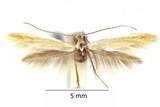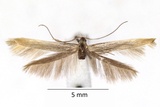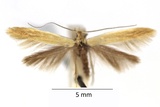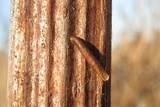Coleophora hydrolapathella Hering, 1921 Species
Last modified: Dec. 6, 2024, 5:21 p.m.
In 1988, the first Belgian specimens of this species were found in AN. A local and very rare species in our country.
Details
- Classification
- Family: Coleophoridae > Genus: Coleophora > Species: Coleophora hydrolapathella
- Vernacular names
- Moeraskokermot (NL), Water-dock case-bearer (EN), Riesenampfer-Sackmotte (DE)
- First mention in Belgium
- De Prins W. 1996. Enkele nieuwe en interessante soorten Microlepidoptera voor de Belgische fauna (Lepidoptera: Nepticulidae, Yponomeutidae, Coleophoridae, Gelechiidae). — Phegea 24: 137–140. On page 139 (as Coleophora hydrolapathella M. Hering, 1921). view page
- Status
-
Native
Distribution
Caterpillar
The pale rose-brown caterpillar has a light-brown head.
Case
The case, constructed by the caterpillar, is very slender and small and measures up to 7–8 mm. The anal area is strikingly paler than the rest of the case. The mouth angle is 0–13°.
See also bladmineerders.be.
Bionomics
The larvae feed on the flowers and the seeds of the hostplant. They are most easily found in August and September.
Fully fed, they attach themselves to a stem of the hostplant to hibernate.
Flight periods
The adults fly in one generation a year from June till early August.
Observed on
- Host plant (species):
- Rumex hydrolapathum
C. hydrolapathella lives monophagously on Rumex hydrolapathum.




